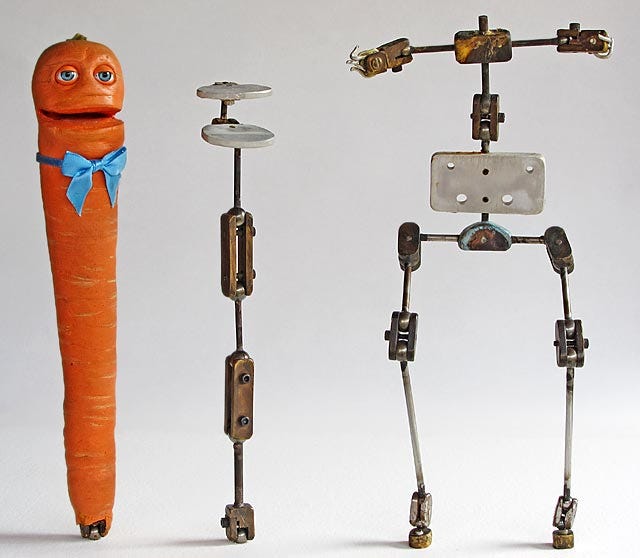
Hello from the start of May.
A new activity in our house: I watch easy drawing videos at the kids’ request and follow the instructions to make pictures for them to color in. Yesterday, Pikachu and a cake slice that was also a unicorn. Reminds me of a stray thought from my early explorations with generative image models: “I think it would be fun to paint or draw by projecting these generated designs onto paper somehow and tracing them from scratch. Then, you get the weird imagination embedded in the original but also the texture of the human hand.”
Here are five fragments that stuck with me last week…
The set of reward signals, and their relative weighting, shapes the behavior we get at the end of training. Defining the correct set of reward signals is a difficult question, and we take many things into account: are the answers correct, are they helpful, are they in line with our Model Spec, are they safe, do users like them, and so on. Having better and more comprehensive reward signals produces better models for ChatGPT, so we’re always experimenting with new signals, but each one has its quirks.
– OpenAI team, “Expanding on what we missed with sycophancy,” May 2, 2025. I followed the ChatGPT sycophancy arc with interest, since LLM personality in general / agreeableness in particular are Diagonal touchstones. Incentives rule everything around us, but here we see that every incentive has a grain all its own.
As James [and the Giant Peach] moved toward production, [Henry] Selick faced no shortage of tension. For one thing, Disney’s animation division was consumed by the studio’s big-ticket foray into computer animation, Toy Story, and its traditionally animated musical The Hunchback of Notre Dame. For another, management shifts had left James a stepchild with one key supporter: Vogel, who supervises Disney’s live-action family films, and who butted heads with Selick, whom he describes as “cranky.” Selick doesn’t disagree: “It’s been a tough relationship,” he says, “but rewarding. We had some real rough spots. We shut down [while] doing rewrites. We laid off people. But I’ve never heard of great movies coming from Party Atmosphere Productions.”
– Anne Thompson, “Behind the scenes of ‘James and the Giant Peach,’” Entertainment Weekly, April 26, 1996. Party Atmosphere Productions! I finished reading James and the Giant Peach to the kids over the weekend and promised them that the movie’s up next, so took some time to do some digging on its history. Turns out James was shot at a studio called Skellington Productions right here in San Francisco and was something of a consolation prize to director Henry Selick after he directed all of Tim Burton’s The Nightmare Before Christmas but got hardly any credit for it. Don’t miss this behind-the-scenes mini-documentary full of 90s flair and chunky CRT screens.
Where I benefit the most from AI is not the hard skills (I can code! I can PM! I can design!) but the management of my own cognitive capacity[.] I know how to fix that bug, or make that page look better, or what I need to say to a customer. But a girl gets tired. The ability to jumpstart or delegate nagging tasks makes it easier to manage where I put my own time and attention.
– Claire Vo on X, May 2, 2025. AI changes what can be accomplished with the two-minute rule, which changes the shape of knowledge work itself. As Claire points out: there’s no need to track tasks that are already done.
The assignment was to animate “Howie”, a beach ball-shaped fat kid running in terror, down a hallway away from an evil Jack-in-the-box. Things went wrong from the start. The shooting stages were all occupied, so management had the horrible idea of setting up a makeshift stage right in the middle of the front production offices. Accordingly, my workspace was just a small curtained-off section in one of the busiest areas of the building, a miserable environment for focusing and concentrating on one’s animation work. Further complicating the situation was the fact that nobody took into consideration the means with which I could actually reach the puppets in order to animate them. The set was walled in on all sides except the front, mostly blocked by a huge Mitchell camera, requiring me to reach in from a very narrow opening. Adding insult to injury, the “Howie” puppet was basically defective. The creature department, normally known for superb work, made this puppet’s foam latex body so dense it resisted extreme poses, which severely limited what I could achieve for a character performance. On top of that, the paint on the puppet did not adhere well and it rubbed off from the handling as the shot moved forward. I was forced to continually touch up the paint while in the process of animating the puppet. It all added up to animation torture!
– Joel Fletcher, “Incident at Skellington Productions,” August 5, 2011. Why are the detailed complaints of domain experts so riveting? I guess because it makes me feel like a trusted confidante who knows enough of what they know to really feel the indignity. My James and the Giant Peach research sent me down a stop-motion rabbit hole that led me to this exquisite personal website of a kind you never see anymore.
On one side, you’ll find a poster indecipherable to AI. On the other, an essay laying out strategies for the production of art, in any medium, that defies the capabilities of AI models: art that is difficult for them to “understand”, art that is impossible for them to imitate.
– Robin Sloan on The Secret Playbook, his new risograph zine. Sold out already! Soon to be in my hands.
Until next time,
Diana
https://dianaberlin.com




